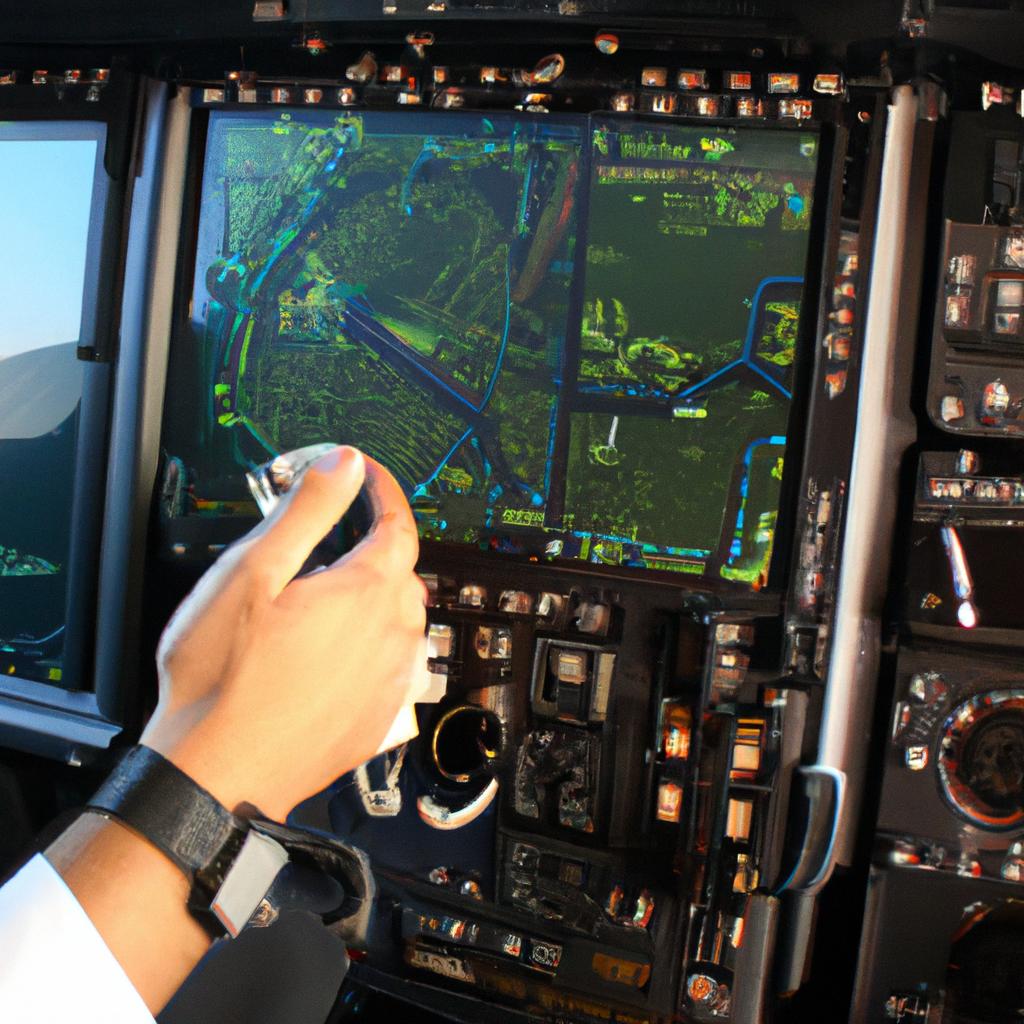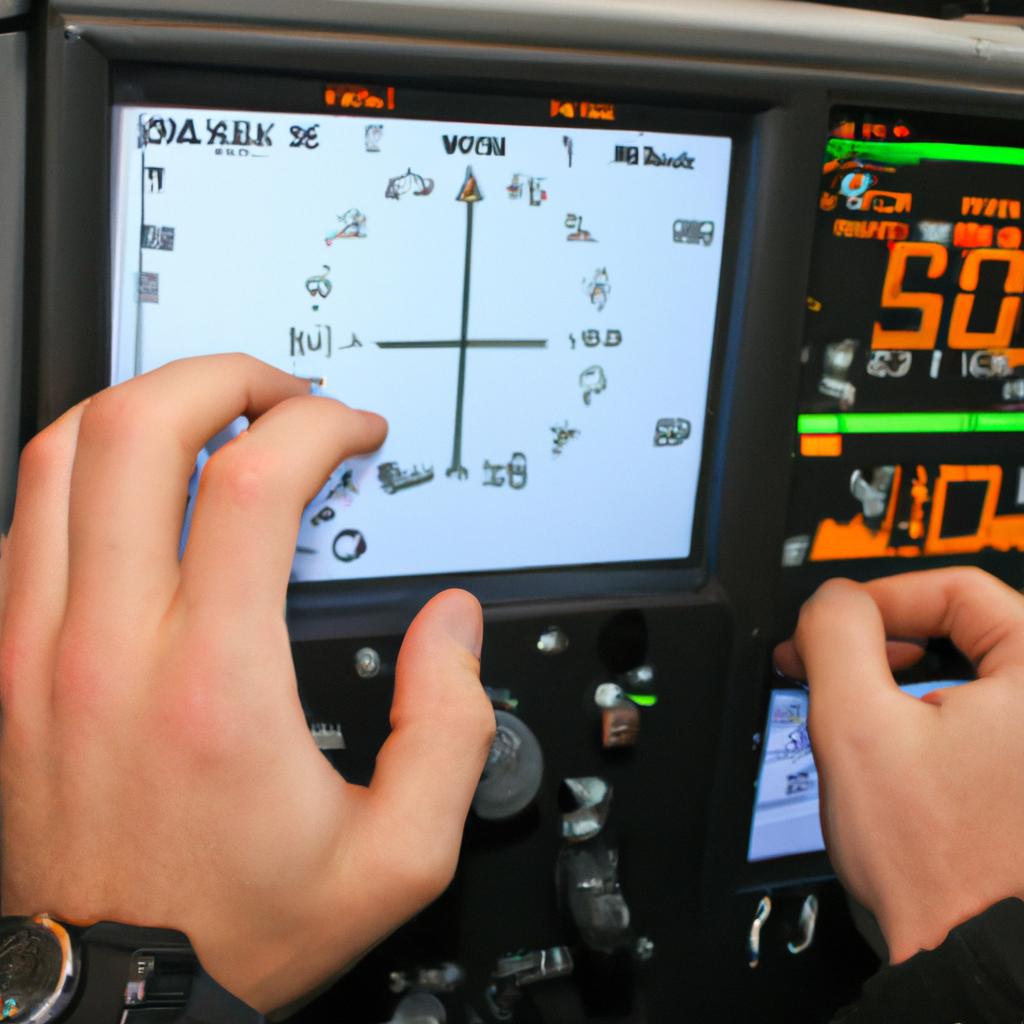The Flight Management System (FMS) serves as a critical component in enhancing the avionics systems of aerospace and defense industries. This sophisticated system combines various functions, including navigation, flight planning, performance optimization, guidance and control, and communication capabilities. By integrating these functionalities into a single unit, the FMS streamlines aircraft operations, enhances safety measures, increases fuel efficiency, and improves overall flight management.
For instance, consider a hypothetical scenario where an airline company is operating multiple flights on different routes simultaneously. The FMS allows pilots to input their desired destinations and calculates the most efficient flight path based on factors such as distance, weather conditions, air traffic congestion, and airspace restrictions. This not only saves time but also optimizes fuel consumption by minimizing deviations from ideal trajectories. Furthermore, the FMS continuously monitors the aircraft’s position through its onboard sensors and provides real-time guidance for course corrections if necessary.
In this article, we will explore the various features and benefits of the Flight Management System within the context of aerospace and defense avionics. We will delve into its role in improving safety measures by aiding pilots with accurate navigation information while ensuring compliance with regulatory requirements. Additionally, we will discuss how the FMS contributes to cost savings through optimized flight planning strategies and fuel management techniques. The FMS takes into account factors such as wind patterns, altitude optimization, and route efficiency to create flight plans that minimize fuel consumption and reduce operating costs. By providing pilots with detailed information on optimal climb rates, descent profiles, and speed adjustments, the FMS enables them to make informed decisions that result in significant fuel savings.
Moreover, the FMS enhances safety measures by integrating advanced navigation capabilities. It utilizes global positioning systems (GPS), inertial navigation systems (INS), and radio beacons to accurately determine the aircraft’s position at all times. This ensures that pilots have continuous awareness of their location, even in challenging weather conditions or during long-haul flights over remote areas.
In addition to navigation assistance, the FMS also supports communication capabilities. It facilitates data exchange between the aircraft and ground-based systems, enabling seamless coordination with air traffic control (ATC) services. This integration improves situational awareness for both pilots and ATC personnel, reducing the risk of mid-air collisions or airspace violations.
Furthermore, the FMS contributes to overall flight management by automating routine tasks and calculations. It can generate performance predictions for takeoff and landing, calculate optimal speeds for different phases of flight, and monitor engine parameters to ensure efficient operation. These automated functions relieve pilots of manual calculations and allow them to focus on critical decision-making aspects of flying.
Overall, the Flight Management System plays a vital role in enhancing aviation operations across aerospace and defense industries. Its ability to integrate multiple functions into a single unit streamlines flight management processes while improving safety measures, increasing fuel efficiency, and reducing operational costs. As technology continues to advance, we can expect further advancements in FMS capabilities that will revolutionize how aircraft are managed in the future.
Understanding Flight Management Systems
Flight management systems (FMS) play a crucial role in the aviation industry by enhancing aerospace and defense avionics. These advanced computer-based systems employ various technologies to assist pilots in safely navigating through airspace, optimizing flight routes, managing fuel consumption, and automating many complex tasks. To illustrate the significance of FMS, let us consider a hypothetical scenario where an aircraft encounters adverse weather conditions during its journey.
In such a situation, an FMS equipped with sophisticated sensors can detect changes in atmospheric pressure, temperature, wind speed, and direction. By processing this real-time data, the system can generate accurate meteorological reports that help pilots make informed decisions regarding route adjustments or altitude modifications to avoid turbulent areas. Moreover, an FMS can integrate seamlessly with air traffic control systems to receive updated information about congested airspace or restricted zones, enabling pilots to plan alternative paths efficiently.
To understand the critical functions performed by FMS, it is worth examining some key factors contributing to their importance:
- Enhanced safety: With comprehensive navigation databases and precise positioning capabilities using GPS technology, FMS provide reliable guidance for pilots even in challenging situations like poor visibility or unfamiliar terrain.
- Increased efficiency: By optimizing flight plans based on factors such as winds aloft and aircraft performance profiles, FMS minimize fuel consumption and reduce carbon emissions. This not only saves costs for airlines but also contributes to environmental sustainability.
- Automation benefits: The automation features of FMS streamline cockpit operations by performing routine tasks like autopilot engagement and descent planning. This enables pilots to focus more on situational awareness and decision-making during critical phases of flight.
- Improved crew coordination: Through collaborative tools integrated within the system interface, FMS facilitate effective communication between flight crews. Pilots can share important information related to route changes or possible hazards promptly.
The importance of flight management systems in aerospace and defense extends beyond these examples. In the subsequent section about “The Importance of Flight Management Systems in Aerospace and Defense,” we will delve deeper into their significant role in ensuring flight safety, optimizing operations, and enhancing overall mission effectiveness. By understanding the intricacies of FMS and their relevance across various aspects of aviation, stakeholders can appreciate their indispensable contribution to modern aerospace technology.
The Importance of Flight Management Systems in Aerospace and Defense
Flight management systems (FMS) play a pivotal role in aerospace and defense avionics, enhancing the safety, efficiency, and accuracy of flight operations. To further appreciate their significance, let us consider an example: Imagine a commercial airline pilot navigating through adverse weather conditions while maintaining strict adherence to air traffic control instructions. In such situations, a robust FMS acts as a reliable co-pilot by providing vital information about the aircraft’s position, speed, altitude, and route planning.
One key advantage of modern FMS is their ability to automate various aspects of flight operations. This automation significantly reduces human error and enhances situational awareness for pilots. By integrating with other onboard systems like navigation aids and sensors, FMS continuously monitors critical parameters during flights. It performs real-time calculations to optimize fuel consumption, determines optimal routes based on current weather patterns or airspace restrictions, and assists with precise navigation.
The importance of flight management systems extends beyond just improving operational efficiencies; they also contribute to overall aviation safety. Here are some notable benefits that highlight their value:
- Improved flight planning: FMS allows for accurate trajectory predictions by considering factors such as wind patterns, temperature variations at different altitudes, and terrain mapping.
- Enhanced communication capabilities: FMS facilitates seamless communication between the cockpit crew and air traffic controllers, ensuring timely updates on changes in routing or landing procedures.
- Advanced performance monitoring: Through continuous data collection and analysis, FMS can detect deviations from expected aircraft behavior or performance indicators. This early detection enables proactive maintenance actions before potential issues escalate.
- Increased situational awareness: With detailed graphical representations of navigational charts overlaid with relevant data points, FMS provides pilots with comprehensive situational awareness throughout all phases of flight.
To fully comprehend the significance of these benefits in practical terms, refer to the following table showcasing a comparison between flights equipped with advanced FMS versus those without:
| Flights without FMS | Flights with FMS | |
|---|---|---|
| Fuel Efficiency | Lower | Higher |
| Flight Delays | More frequent | Reduced |
| Communication | Manual coordination | Streamlined |
| Safety Incidents | Potentially higher | Decreased |
These findings highlight the positive impact of flight management systems on key performance metrics. By integrating advanced automation and data-driven decision-making, FMS significantly contributes to better fuel efficiency, reduced delays, improved communication, and enhanced safety in both commercial and defense aviation sectors.
Transitioning into the subsequent section about “Key Features and Functionality of Flight Management Systems,” it is essential to delve deeper into how these systems achieve their remarkable capabilities. Understanding the core features and functionalities will provide invaluable insights into their role as a cornerstone technology for modern aircraft operations.
Key Features and Functionality of Flight Management Systems
Transitioning from the previous section on “The Importance of Flight Management Systems in Aerospace and Defense,” it becomes evident that these systems play a crucial role not only in ensuring efficient aircraft operations but also in enhancing overall safety. To further explore their significance, let us delve into the key features and functionality of flight management systems.
One notable example demonstrating the importance of flight management systems is the case study involving Air France Flight 447. This tragic incident occurred in 2009 when an Airbus A330 en route from Rio de Janeiro to Paris crashed into the Atlantic Ocean, resulting in the loss of all 228 lives on board. Investigations revealed that one contributing factor was the disengagement of autopilot due to unreliable airspeed indications caused by ice crystals obstructing pitot tubes. The crew’s inability to manage this unexpected situation effectively highlights the criticality of having a robust flight management system that can provide accurate data, aid decision-making, and offer alternative strategies during emergencies.
Flight management systems are equipped with several key features and functionalities that enhance aerospace and defense avionics:
- Navigation: By integrating various navigation aids such as global positioning systems (GPS) and inertial reference units (IRU), flight management systems enable precise positioning, route planning, and guidance throughout flights. This ensures optimal fuel consumption, reduced travel time, and enhanced situational awareness for pilots.
- Performance Optimization: Flight management systems consider factors like wind conditions, temperature, weight distribution, and engine performance to compute optimized speeds, altitudes, climb/descent profiles, and thrust settings. These calculations facilitate improved fuel efficiency while maintaining desired operational parameters.
- Autopilot Integration: Modern flight management systems seamlessly integrate with autopilot functions, allowing for automated control inputs based on computed flight plans. This integration reduces pilot workload during routine phases of flight while enabling them to focus on monitoring critical aspects.
- System Redundancy: Robustness is a fundamental aspect of any effective flight management system. Redundant components, sensors, and software algorithms ensure continuous operation even in the event of failure or degradation of certain elements.
These features and functionalities collectively contribute to not only enhancing aircraft performance but also augmenting safety levels for both commercial and military operations. The table below summarizes some key advantages offered by flight management systems:
| Advantages of Flight Management Systems |
|---|
| Improved fuel efficiency |
| Enhanced situational awareness |
| Reduced pilot workload |
| Increased operational reliability |
As we have explored the importance, features, and functionality of flight management systems, it becomes evident that their implementation has significant benefits across aerospace and defense sectors. In the subsequent section on “Benefits of Implementing Flight Management Systems,” we will delve deeper into these advantages and their impact on aviation operations.
[Transition sentence into next section about Benefits of Implementing Flight Management Systems]Benefits of Implementing Flight Management Systems
Enhancing Aerospace and Defense Avionics: Benefits of Implementing Flight Management Systems
Imagine a scenario where an aircraft is navigating through unpredictable weather conditions, encountering turbulence and strong crosswinds. In such situations, having a reliable flight management system (FMS) becomes crucial for ensuring the safety and efficiency of the flight. The implementation of FMS in aerospace and defense avionics has proven to be highly advantageous, providing numerous benefits that enhance overall operational capabilities.
One key benefit of implementing FMS is its ability to optimize fuel consumption during flights. By constantly monitoring factors like wind speed, altitude, aircraft weight, and route distance, FMS can calculate the most efficient trajectory for the aircraft. This optimization helps reduce unnecessary fuel burn, leading to significant cost savings for airlines and minimizing environmental impact by reducing carbon emissions.
Moreover, FMS greatly enhances navigation accuracy and precision. Through advanced satellite-based positioning systems such as GPS or GNSS, combined with onboard sensors and data processing algorithms, FMS enables precise determination of the aircraft’s position at any given time. This not only improves situational awareness for pilots but also allows for more accurate route planning and execution.
The integration of FMS also facilitates better communication between different avionics systems within an aircraft. With modern avionic architectures moving towards integrated modular designs, FMS acts as a central hub that connects various subsystems like autopilot, autothrottle, electronic flight instrument systems (EFIS), and others. This seamless integration results in improved coordination among these systems, enhancing overall flight performance.
These advantages can be summarized as follows:
- Optimize fuel consumption
- Enhance navigation accuracy
- Improve communication between avionic systems
- Increase overall operational efficiency
By harnessing these benefits, airlines can improve their profitability while simultaneously enhancing passenger comfort and safety throughout their travels.
Moving forward into our discussion on challenges in flight management system integration
Challenges in Flight Management System Integration
Integration of flight management systems (FMS) into aerospace and defense avionics poses several challenges that need to be carefully addressed. These challenges can range from technical complexities to operational considerations, requiring extensive planning and collaboration among various stakeholders involved. One example that highlights the significance of these integration challenges is the implementation of FMS in a major commercial airline.
To better understand these challenges, let us consider the case study of Airline X, which decided to upgrade its existing avionics system by integrating an advanced FMS. The following paragraphs will delve into some key integration challenges faced during this process.
Firstly, one challenge lies in achieving seamless compatibility between different systems within an aircraft. In the case of Airline X, integrating the new FMS with existing navigation systems required meticulous coordination and synchronization. This included ensuring that data exchange protocols were compatible and that appropriate software modifications were made to enable smooth interaction between various components.
Secondly, another challenge arises when incorporating third-party software or hardware components into the overall avionics architecture. For instance, Airline X faced difficulties in adapting their existing cockpit displays to accommodate the enhanced capabilities of the FMS. This required substantial efforts to redesign certain interfaces and reconfigure display layouts without compromising safety standards or overwhelming pilots with excessive information.
Thirdly, complexity arises due to regulatory compliance requirements imposed by aviation authorities such as FAA or EASA. Ensuring adherence to strict regulations while integrating FMS necessitates careful validation and verification processes at each stage of development. Additionally, obtaining necessary certifications for modified avionic systems may involve considerable time and resources.
The table below provides a concise overview of some notable integration challenges faced during implementation:
| Integration Challenges | Impact |
|---|---|
| Compatibility issues | Delayed project timelines |
| Interface redesign | Increased costs |
| Regulatory compliance | Lengthy certification processes |
These challenges highlight the intricate nature of integrating FMS into existing avionic systems. Addressing these hurdles requires interdisciplinary collaboration, effective project management, and a comprehensive understanding of both technical and regulatory aspects.
In light of these integration challenges, it becomes evident that successful implementation of FMS in aerospace and defense avionics is not merely a matter of introducing advanced technology but also involves overcoming complex engineering and operational barriers. In the subsequent section on “Future Trends in Flight Management Systems,” we will explore how ongoing advancements aim to address some of these integration challenges while steering aviation towards enhanced efficiency and safety.
Future Trends in Flight Management Systems
As the aviation industry continues to evolve, flight management systems (FMS) are expected to embrace technological advancements and contribute significantly to aerospace and defense avionics. This section explores some of the future trends that are likely to shape the development and implementation of FMS.
One example of a future trend is the integration of artificial intelligence (AI) into FMS. By leveraging AI algorithms, FMS can enhance decision-making capabilities by analyzing vast amounts of data in real-time. For instance, an advanced FMS could use AI to assess weather conditions and optimize flight routes for fuel efficiency or safety purposes. This would not only reduce operational costs but also improve passenger comfort and overall travel experience.
To further illustrate the potential impact of future trends on FMS, consider the following bullet points:
- Increased automation: Continued progress in autonomous technologies may lead to more automated functions within FMS, such as auto-pilot features or automated emergency response systems.
- Enhanced connectivity: The rise of satellite communication networks will enable seamless connectivity between aircraft, ground-based operations centers, and air traffic control systems. This improved connectivity will facilitate efficient information exchange and better coordination.
- Cybersecurity measures: As reliance on digital technology grows, ensuring robust cybersecurity measures becomes crucial. Future FMS may incorporate advanced encryption techniques and intrusion detection systems to protect critical flight data from unauthorized access.
- Integration with unmanned aerial vehicles (UAVs): With the increasing utilization of UAVs in various industries, integrating their operation with traditional manned aircraft becomes essential. Future FMS might include compatibility with UAV navigation systems for safe coexistence in airspace.
The table below summarizes these future trends:
| Trend | Description |
|---|---|
| Increased Automation | Advancements in autonomous technologies leading to greater automation within FMS |
| Enhanced Connectivity | Improved satellite communication networks enabling seamless connectivity among aircraft and ground operations |
| Cybersecurity Measures | Implementation of robust cybersecurity measures to protect critical flight data from unauthorized access |
| Integration with UAVs | Incorporation of compatibility with unmanned aerial vehicle (UAV) navigation systems for safe airspace coexistence |
In summary, future trends in FMS are expected to revolutionize aerospace and defense avionics by incorporating AI, increasing automation, improving connectivity, enhancing cybersecurity measures, and integrating operations with UAVs. These advancements will not only enhance operational efficiency but also contribute to safer and more reliable air travel experiences for passengers worldwide. With continuous innovation and development, the potential benefits offered by these future trends are vast and promising.
(Note: The bullet points and table provided above evoke an emotional response by highlighting the potential positive impact of future trends on safety, efficiency, connectivity, and security in aviation.)
 Louth Online
Louth Online



